Yukon Passenger License Plates |
|
Starting in 1955, all North American licence plates were expected to conform to a new standard dimension of six inches in height by twelve inches in width. For the Yukon, this meant the abandonment of the unique shape that had characterised the Territory's plate between 1952 and 1954. Common elements, such as the "Land of the Midnight Sun" slogan and Gold Panner symbol were retained and would remain unchanged for the next 16 years. |
| 1955 | ||||||||||||||||
1-digit
|
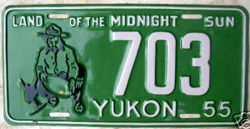 |
|
|
|||||||||||||
| 1956 | ||||||||||||||||
3-digit
|
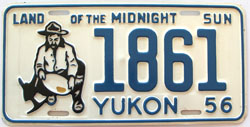 |
|
||||||||||||||
| 1957 | ||||||||||||||||
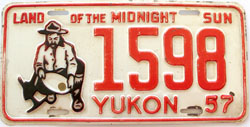 |
|
|||||||||||||||
| 1958 | ||||||||||||||||
1-digit
|
2-digit
|
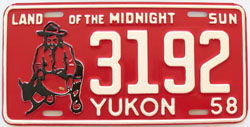 |
|
|||||||||||||
| 1959 | ||||||||||||||||
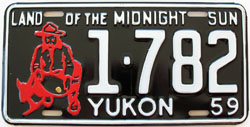 |
|
|||||||||||||||
| 1960 | ||||||||||||||||
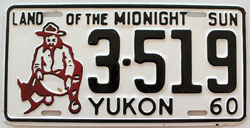 |
|
|||||||||||||||
Colour Schemes (1960s) A common practice amongst motor vehicle registration authorities in this period was to exchange examples of their licence plates each year in order to assist local law enforcement with the identification of valid licence plate types from other states and provinces. Throughout the 1960s the Yukon would mail a sample plate (generally displaying "0000") to each province and state in North America and would expect to receive a similar sample plate in return. The selection of a colour scheme was an important undertaking as it was commonly accepted amongst issuing authorities that they could not use the same colour as any neighbouring jurisdiction in the same year. As the 1957 colour scheme flap between British Columbia and Alberta had demonstrated, avoiding conflict was important, and, consequently, there was much discussion amongst the western provinces and territories regarding forthcoming colour schemes. Not surprisingly, when the primary colours of blue, red and green had already been spoken for, the Territory would look to some of the sample plates it had received in previous years from other jurisdictions for inspiration and as a possible template for future Yukon plates. Oakalla's solution to this was to suggest that Yukon plates use the reverse of the colours employed on British Columbia licence plates the year before. So, for 1961, this would have been the reverse of the "background of pastel rose with maroon numerals" that had been used in BC in 1960. This was principally a cost saving measure that would eliminate the need for Oakalla to purchase additional paint colours for the Yukon's relatively small plate run. While the Territory partially agreed to this suggestion by using "maroon" for its numerals and letters (while also forgoing the use of a third colour on the "Gold Panner" emblem), it would look to the 1962 Nova Scotia plate for its 1963 colour scheme and the 1960 Alberta plate for its 1964 colour scheme (the 1964 plates were originally intended to be a dark-orange-on-white).
Over the coming years, Oakalla would increasingly play a dominant role in determining the ultimate colour of Yukon licence plates. Apart from being behind the abandonment of a separate colour on the "Gold Panner" emblom, in 1963, the Territory was advised that Oakalla would be ordering pre-painted white steel and that it would be more cost effective if 1964 and 1965 Yukon plates employed a white background and that the Territory select "numeral colours that would fall in line with this plan." If, however, the Territory desired licence plates of a different background colour, the cost would of production would increase considerably for the purchase of such a small quantity of pre-painted material. The following year (1964), Oakalla advised that British Columbia was exploring the possibility of introducing a licence plate that could be renewed through the issuance of a plastic registration decal and had "purchased material that has proven to be satisfactory for periods of up to four years". If also introduced to the Yukon, such a plate held the potential for "a considerable saving over your present programme". Alternately, the Territory was encouraged to give consideration to introducing a standardised rotation between green-on-white and red-on-white colours in place of regsitration decals. Such a suggestion is not surprising as British Columbia had adopted a similar policy a few years earlier whereby the colour scheme would now rotate starting in 1963 between white-on-blue and blue-on-white plates (a cycle that has now continued for almost fifty years). The Registrar of Motor Vehicles, H.J. Taylor, was skeptical of the registration decal as "there are considerably more miles of gravel road in the Territory than in the provinces and a licence plate in this vicinity, I can assure you, takes a considerable pounding during the summer months." On the matter of the rotating colour scheme, Taylor noted that Alberta would be using a red-on-white colour scheme on their 1965 plates and that he was concerned about other potential colour conflicts. So, to avoid confusion he suggested alternating between red, green and black, but had not yet decided what the fourth colour would be as 1967 was the Canadian Centennial and he wanted to see what, if anything, other provinces were going to do to mark the event. |
| 1961 | ||||||||||||||||
|
||||||||||||||||
The Dot Collector's of licence plates are invariably drawn to small variations that may occur duing the manufacturing of a plate run, such as a change of die types, small colour variations, or the placement of a dash/dot. Generally, these are ultimately seen to be interesting but inconsequential aspects of a particular plate issuance. That is why it is rather heartening to read that in 1962 the Registrar of Motor Vehicles, H.J. Taylor, took the time to request of Oakalla that they "please discontinue using the dot after the first number in the thousand series." Despite a similar request having been made of Oakalla when the 1961 plate order had been placed in October of 1960, all of the four-digit plates for this year appear to have been manufactured with "the dot". Yet, when the Territory was subsequently required to order an additional over-run allotment of 250 plates numbered 3751 to 4000 in June of 1961, Oakalla appears to have finally paid heed to the new direction to drop the dot. For whatever reason, Oakalla either disregarded or forgot about this direction to drop the dot when they began to manufacture the 1962 four-digit plates a few months later (and repeated this with 1963 plates as well). It would only be with the 1964 issuance that the use of the dot on four-digit plates was permantly dropped. |
| 1962 | ||||||||||||||||
|
||||||||||||||||
| 1963 | ||||||||||||||||
|
||||||||||||||||
HMCS Yukon In March of 1963, the Territorial Secretary placed a special order with Oakalla for an undated pair of No. 263 licence plates (utilising the 1963 colour scheme) for use by the Commissioner on an unspecified "special occasion". The Territorial Agent in Dawson City was subsequently notified to withdraw the actual 1963 No. 263 plate from distribution. For unknown reasons, the special occasion never transpired, the undated plate was no longer needed, and the Agent in Dawson City was advised to place the actual No. 263 plates back into their proper sequence.
A clue to the original purpose of this plate may be gleaned from subsequent corresdonance wherein the Lieutenant Commander of the HMCS, Yukon requested plate No. 263 for use on the ship's Jeep for the 1967 registration year. Interestingly, HMCS Yukon was a "Designated Destroyer Escort" (DDE) whose number was No. 263, and had been commissioned into the Royal Canadian Navy on 25 May 1963 - possibly this was the "special occassion" the Territorial Secretary had requested the undated plate. Writing in early 1968, the Lieutenant Commander of the HMCS Yukon, W.J. Thomas, commented that "it is with pleasure that we display the Yukon Territory licence plate on our jeep and add that extra something that helps male us proud of our ship and the name it carries." |
| 1964 | ||||||||||||||||
|
||||||||||||||||
Slogans In late 1964, the Territory's Director of Travel & Publicity, W.J.M. Gibson, wrote the Territorial Secretary, H.J. Taylor with a concern that "many of our residents who drive their automobiles to other parts of Canada and the U.S. have discovered the keen interest created by our motor vehicle license plates. It is disturbing however, to discover also that most people, including other Canadians, think that the Yukon is "in Alaska". To rectify this situation, it was suggested that the slogan "Land of the Midnight Sun" be replaced by "CANADA", as it was thought this would assist the Travel & Publicity Department "in its efforts to educate the Outsiders." The Territorial Secretary's response was that "Canada" was not shown on any other provincial licence plate nor was the designation "U.S.A." shown on any plates in the States, and that the general trend was "to reduce the number of words shown on licence plates rather than to increase same." That said, he did open the door to replacing the "Land of the Midnight Sun" slogan, but cautioned that "replacing this slogan would receive considerable objection from people throughout the Territory as this has been our slogan for a considerable number of years." |
| 1965 | ||||||||||||||||
|
||||||||||||||||
| 1966 | ||||||||||||||||
|
||||||||||||||||
| 1967 | ||||||||||||||||
|
||||||||||||||||
1967 Canadian Centennial As mentioned previously, the Registrar of Motor Vehicles, H.J. Taylor, was unsure of what colours to use on the Territory's licence plates in 1967 as it would be the Canadian Centennial and he wanted to see what, if anything, other provinces were going to do to mark the event. The National Centennial Commission had written the Territory on February 17, 1964, to advise that they were "investigating the feasibility of having motor vehicle licence plates for 1967 carry some suitable motif or message to indicate that it is the centennial year of Confederation in Canada", and Taylor had responded te following week that "distinctive markings for the Centennial Year ... seems quite feasible at this time" but "would necessitate the manufacture of new dies ... [and] more than the normal time for printing." By September 1, 1965, Taylor was advising of his earlier discussion with Jack Gibson regarding the placement of the word "CANADA" on Yukon plates and that he "did not think too much of the idea at that time and I must say, I am not any more in favour of it now than I was then. As you know, our licence plate is somewhat crowded and I think the use of the emblem would lose its significance. I would recommend that rather than an emblem actually embossed in the licence plate, it may be more effective to have a decal that could be stuck to the automobile windshield or the back window, or possibly both. I do think this would be more apt to draw the attention of the public than the suggested licence plate." On February 18, 1966, Taylor advised Oakalla that while he was thinking of having a special black-on-gold colour scheme for the 1967 plates, he was "not in favour of any special insert such as the Centennial emblem on our licensce plates" but that he did not "plan to make any final decision on this matter until the next Motor Vehicle Conference, possibly some Canada-wide decision may be reached regarding the Centennial plate." By May 26, 1966, the Executive Assistant to the Federal Minister of Northern Affairs was writing the Commissioner suggesting that in place of the No. 1 plate, the numbers 1867 and 1967 could be used in some way on their vehicle to mark the Centennial. In addition, that there had been the question as to whether Yukon plates "should show some symbol or give some distinctive recognition to [the] Centennial year"? In reponse, Taylor noted that "this has been discussed but was thrown out in favour of supplying an attachable tag or window sticker." By June 21, 1966, Taylor was advising Oakalla that "there would be no change in printing for the Centennial year." |
Registration Year Throughout most of the 1950s and 1960s, motorists were able to display their licence plates until the 31st of March in the following year. So, for example, a 1960 licence plate remained valid until March 31, 1961, with the 1961 plates going on sale on April 1st. Motorists were generally given a 30 day grace period in which to obtain their new plates, meaning - using the previous example - that a 1960 plate could be displayed until April 30, 1961, after which any motorist who had not yet acquired the new plates faced potential enforcement action. This was changed in 1967, as motor vehicle licences beagn to be issued from the 1st of February to the end of March. |
| 1968 | ||||||||||||||||
1-digit
|
|
|||||||||||||||
Colour Schemes (1968) For 1968, Oakalla suggested that the Yukon use either a green or maroon colour on a white background, but the Registrar did not feel this was appropriate as Alberta was going to be white-on-green, Saskatchewan was to be green-on-white, while BC was to be blue on white, and that "the colour we are practically forced to use this year is black on white".
|
| 1969 | ||||||||||||||||
|
||||||||||||||||
Colour Schemes (1970) For the 1970 plate, the Territory was "considering two colours; the reverse of this year's color which would be a black plate with yellow numerals, or if it would be more convenient in case you have a quantity of pre-painted white metal, we would consider green lettered numerals on a white background." Due to the proliferation of various licence plate types in British Columbia throughout the 1960s, the Oakalla Plate Shop Business Manager, J.D. White, attempted to project the various colour combinations that would be required for the forthcoming decade for all of the various plates issued by British Columbia as well as the Yukon (which required approximately 28 colour combinations):
For the Yukon, it was envisioned that a four-year cycle could be implemented, generally employing a white enamal background with coloured numberals, but for 1970 it was advised that Oakalla could see no other alternative to the green-on-white scheme. The Territory agreed to this as well as the orange-on-white scheme for 1971 and turquoise-on-white scheme for 1972. |
| 1970 | ||||||||||||||||
1-digit
|
|
|||||||||||||||
Christopher Garrish & Ron Garay |